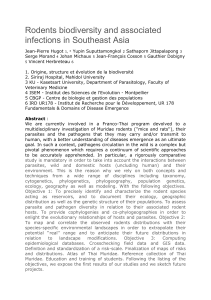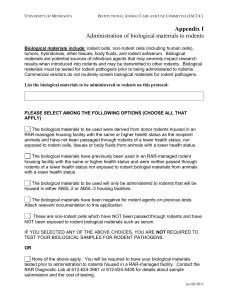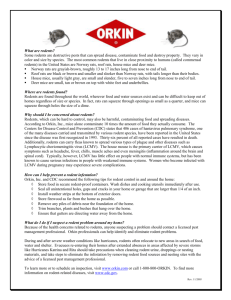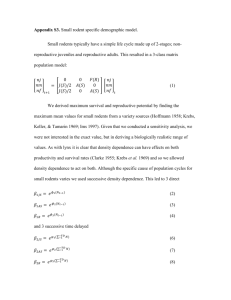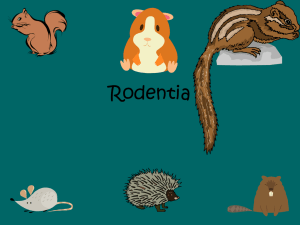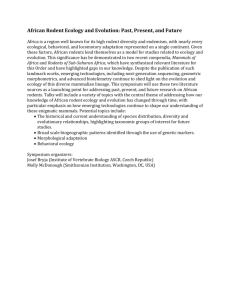Rodent Adaptations
advertisement
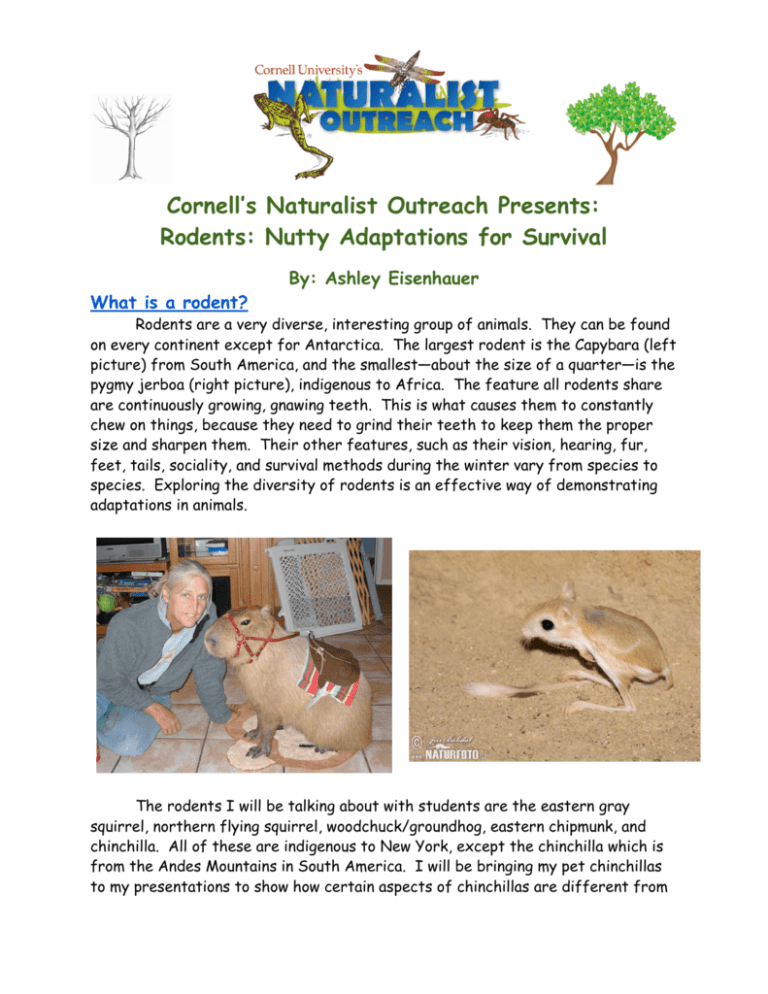
Cornell’s Naturalist Outreach Presents: Rodents: Nutty Adaptations for Survival What is a rodent? By: Ashley Eisenhauer Rodents are a very diverse, interesting group of animals. They can be found on every continent except for Antarctica. The largest rodent is the Capybara (left picture) from South America, and the smallest—about the size of a quarter—is the pygmy jerboa (right picture), indigenous to Africa. The feature all rodents share are continuously growing, gnawing teeth. This is what causes them to constantly chew on things, because they need to grind their teeth to keep them the proper size and sharpen them. Their other features, such as their vision, hearing, fur, feet, tails, sociality, and survival methods during the winter vary from species to species. Exploring the diversity of rodents is an effective way of demonstrating adaptations in animals. The rodents I will be talking about with students are the eastern gray squirrel, northern flying squirrel, woodchuck/groundhog, eastern chipmunk, and chinchilla. All of these are indigenous to New York, except the chinchilla which is from the Andes Mountains in South America. I will be bringing my pet chinchillas to my presentations to show how certain aspects of chinchillas are different from the rodents that live here in New York because of the climate difference. Some of these differences include larger ears for heat dissipation, thick fur for cold nights, and large herd sociality. Local critters that are often mistaken as rodents are rabbits, which are actually Lagomorphs. This is a common misconception because they also have continuously growing teeth and are constantly chewing on something. The main difference is seen in the dentition—Lagomorphs have 4 incisors, two in the front and two right behind those ones, compared to rodents that only have two incisors. Presentation Modules: 1.) Good Vision and Hearing • Rodents have big eyes on the side of their faces. This allows them to see in the dark and have a greater field of view to see predators approaching. • Ears are important for hearing, but also a crucial factor in controlling body temperature. Small ears allow the body to maintain a higher temperature, while large, thin ears allow heat to easily dissipate from the body. 2.) Gnawing Teeth • Rodents have 2 incisors that grow continuously, and naturally sharpen themselves. This is why rodents are constantly chewing on things! The size and number of the molars in the back of the jaw can differ based on the diet of the animal. •Lagomorphs (rabbits) are often mistaken as rodents because they continuously chew as well. They also have continuously growing incisors, but they have 4. There are two in the front, and two in the right behind the front incisors. They also have small molars, since they generally eat soft flora. 3.)Thick Fur • Fur aids in keeping animals warm and allows them to be camouflaged in their environment. Some furs can be thicker than others based on their environment and activities (ex. beaver has thick fur because it goes in the water). The animal pictured below is a baby groundhog/woodchuck. 4.) Dexterous Feet • Dexterous means manipulative. • Feet differ based on the way an animal moves, eats, and behaves. Climbers and burrowers have claws. • Rodents have hand-like paws so they can easily pick up their food and eat it. The rodents I will be talking about generally eat seeds from various trees that are hard to eat. If they had paws like dogs, they would not be able to eat the seeds from a pinecone. Lagomorphs do not have hand-like paws because they generally eat soft grasses on the ground. 5.) Bushy Tail • Tails can help keep animals warm when they curl up in a ball. • They also help animals steer and stay balanced while they are climbing and running. • For gray squirrels, the tail acts as a cushion if they fall from the trees. • For flying squirrels, the tail helps them glide, as it is flat and long and serves as a parachute. 6.) Social • Benefits of being social: body warmth from nesting together, lesser risk of predation, easier to rear young (flying squirrels pictured below). • Cons of being social: higher competition for food sources, having to share everything • Benefits of being antisocial: you only have to look after yourself • Cons of being antisocial: nesting alone, higher risk of predation 7.) Hibernation • Of the animals listed, only groundhogs and chipmunks (picture) hibernate. • Animals that hibernate fatten themselves up in the summer. When it’s time to hibernate they dig burrows in the ground. Their metabolism and heart beat slow down drastically. • Animals that do not hibernate have to continuously feed themselves throughout the winter in order to keep their metabolism fast enough to keep warm. 8.) Where to find them locally • I will show the students pictures of rodent and rabbit tracks. • Flying squirrels prefer piney areas. • Other squirrels (gray and chipmunk) like to live near deciduous, nut producing trees. • Rabbits and groundhogs are found in flat, grassy areas. Rabbit Tracks Squirrel Tracks: 5 front toes, 4 back toes Sources: http://www.nyfalls.com/Wildlife.html www.arkive.org http://www.chinchillaplace.com/blog/bid/4146/Introducing-Chinchillas http://users.tamuk.edu/kfjab02/Biology/Mammalogy/systematics/ A8glires.htm
